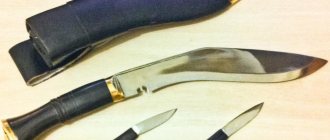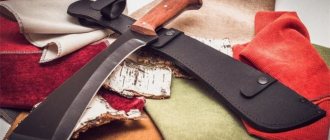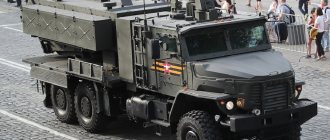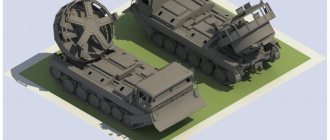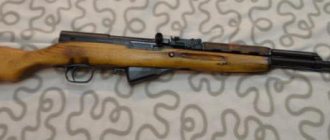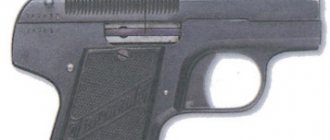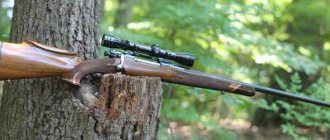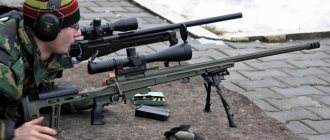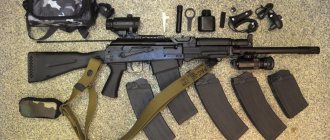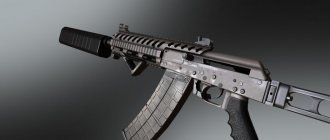In 1977, soldiers of the Austrian army received new StG 77 (AUG) rifles. However, unlike the previous model, this rifle unit did not come with a bayonet.
Apparently, Austrian politicians considered that such bladed weapons were inhumane and would encourage the aggressiveness of soldiers, which contradicts the purely defensive military doctrine of Austria. However, since its introduction, the bayonet has evolved significantly and has become a multi-purpose tool. Therefore, the new rifle unit should also be equipped with a piercing-cutting product. Soon it became the Glock 78 bayonet. Information about the design of a combat blade, its purpose and technical characteristics is presented in this article.
A little history
The knife was created on a competitive basis by three companies: the Austrian Glock GmbH, Ludwig Zeilter and the German Eickhorn. Due to the fact that the Austrian army, as the customer, put forward a number of requirements regarding the design and use of materials, the presented knives were very similar in appearance and design. The blade was developed with the participation of the Austrian army special forces Jagdkommando. Soon a pilot batch of knives from the Zeilter company was released. The expert commission liked the model, but the company unexpectedly went bankrupt and left the competition. Judging by the reviews of experts, the knife was of high quality. The contract for the supply of combat blades was received by the Glock GmbH company, which produced pistols and various army equipment: machine gun belts, sapper blades, etc. Judging by the reviews, the Glock 78 knife was lighter than previous models, structurally simpler and easily attached to army uniforms.
Knife Glock 78 and Glock 81 - differences
Everything is simple here: 78 does not have a saw on the butt, but 81 does. The saw was originally intended for sawing various branches when constructing camouflage shelters.
Therefore, the Glock 81 knife is more likely intended for entrenching and household activities, while the Glock 78 knife is more reminiscent of a classic bayonet, which does not have clinging protrusions on the blade.
Description
Externally, the Glock 78 knife does not look very aesthetically pleasing. The reason for this is the presence of a crosshair in the form of a stamped part. However, as experts say, this is not considered a disadvantage in a tactical knife. At one end the crosshair was bent in such a way that you could rest your thumb on it.
In addition, this element can be used as an opener. Judging by the reviews, bottles and boxes of ammunition can be easily opened using the Glock 78 knife. A blade with a clip-point side profile, also called a “bowie”. In the production of FM 78, spring carbon steel is used, which is subject to heat treatment. The knife has a black oxide coating that prevents corrosion.
It is noteworthy that for most combat knives the strength indicator varies from 58 to 62 units. In FM 78 it is only 55 HRC. According to experts, this does not mean that the Austrian bayonet knife uses low quality steel. The Austrian designers deliberately underestimated the Rockwell scale. The developers pursued the main goal - to make the knife more elastic and not so fragile, and for this it was necessary to reduce the hardness. As a result, sharpening the blade became easier. The handle is made from polyamide, which is used to make frames in Glock pistols. This material has high mechanical strength and wear resistance. In addition, polyamide is resistant to aggressive environments. So that the fighter could securely hold the knife in his palm, the surface of the handle was made rough. Additionally, the knife handle was equipped with five transverse annular grooves. There is a special cavity inside the handle that can be used as a pencil case. It closes tightly with a plastic lid.
Structural and functional features of Glock knives
What is
The Glock company included two letters in the name of its knives - FM, which are an abbreviation of the word Feldmesser, which translated means “field knife”. A synonym for the word “field” in this case is the term “tactical”. This blade differs from other types of knives:
- purpose;
- ergonomic characteristics;
- material, size and shape of the blade;
- shape and material of the handle;
- way of wearing;
- other, no less important details, right down to the sharpening angle of the blade.
In addition, the Glock knife can be attached to a rifle. For this purpose, there is a recess on the handle and a bend on the guard. A simple operation turns the blade into a bayonet.
The Feldmesser is a combat knife, bayonet, survival tool and utility tool.
Due to its versatility, quality and low cost, this model of bladed weapon was included in the equipment of soldiers in Austria, Germany and a number of other countries.
History of invention
Austria is a neutral state, but provides the best weapons for its army. In 1977, the next stage of equipping the ground forces with new equipment, including personal weapons, was underway. Infantrymen received the 1977 assault rifle or Sturmgewehr 77 (StG 77).
It looked like an avant-garde design achievement, but had a peculiarity - the absence of a bayonet. The Austrian political leadership pursued a pacifist policy.
The participation of the national army in hand-to-hand combat was not expected, so the use of piercing and cutting objects seemed to be an attribute of the past. The military did not agree with this and decided that the infantryman needed to be re-equipped. This is how an application for the design of a combat knife appeared.
The requirements for the product were formulated by army specialists and supplemented by experts from special forces. The order ultimately went to Glock GmbH. In 1978, the Feldmesser 78 or FM 78 was released. Three years later, the Glock 81 or FM 81 was developed. A saw appeared on the butt of this product.
It was because of this modification that the FM 81 did not enter service, since the use of weapons that would cause additional suffering to the enemy was prohibited in the country, which was in accordance with the rules of war agreed upon in The Hague in 1899. Nevertheless, both types of bladed weapons are still produced and exported.
When developing FM 78 and FM 81, the successful experience of other countries was taken into account. Knives whose main purpose was bayonet functions were not considered. The designs of edged weapons of special forces were studied.
| A country | Model | date of creation | total length | Blade length | Weight |
| USA | Buck M9 MB | 1973 | 350 mm | 200 mm | 370 g |
| USSR | Scout knife "Cherry" | 1943 | 270 mm | 158 mm | 150 g |
| USA | Ka-Bar (USMC Mark II) | 1942 | 298 mm | 170 mm | 320 g |
Created in 1963, Glock GmbH initially had nothing to do with weapons - until 1977, the company produced only ammunition such as sapper blades. The owner of the company, Gaston Glock, suddenly turned from a manufacturer of shovels into a creator of advanced personal weapons.
Main characteristics
Feldmesser 78 outperformed its competitors due to its simplicity of design. Its weight turned out to be minimal: 202 g with a length of 290 mm. Attaching to ammunition involved different methods. An important point was the final cost of the product – about €30.
Blade
The length of the blade, made of common carbon steel grade 1095, is 165 mm. The thickness of the butt is 5 mm, the maximum width of the blade is 22 mm. To eliminate glare, the material is blackened.
By using ordinary metal instead of stainless steel, Glock specialists reduced the cost of construction. This steel is hardened to 55 HRC. Not very high hardness levels increase the blade's resistance to impact loads.
No matter how unpretentious a weapon may be, it requires proper care: the blade must be wiped, sometimes coated with a thin layer of lubricant. Regarding sharpening, experts do not recommend bringing the blade to razor sharpness: the knife is intended for rough military work; an overly sharp blade can injure the owner.
Handle
Handle length – 125 mm. The material used is high-strength polyamide. The same plastic is used to make the outer body of the Glock pistol and has the following properties:
- it is rough and does not slip even in wet hands;
- does not prick or cut, that is, it has mechanical strength;
- not susceptible to aggressive environments.
For greater reliability when holding the handle, five transverse grooves are made. The inside of the piece is hollow and reminds us that a Glock knife can quickly turn into a bayonet. The pencil case formed inside the handle does not perform any utilitarian functions.
Garda
The guard, also known as the cross guard, protects the owner’s hand. When striking or performing other actions, your fingers may slide onto the cutting part of the blade. This part is useful when performing any type of work as a stop, which makes it possible to significantly increase the pressure on the knife.
There is a slight bend on the cross. Together with the depression in the handle, it is involved in attachment to the rifle in cases where the knife serves as a bayonet. In everyday life, this bend helps open bottles.
Sheath
The carrying case is much more unique than the weapon itself. The sheath is super-light, with clever drainage holes, weighs only 85 g. It is a one-piece plastic product without a single metal addition, made in 3 colors: black, sand and khaki.
The latch on the guard is made of the same high-strength plastic, holding the blade in the sheath. Thanks to this design, the weapon is fixed as securely as possible: even if a soldier hangs upside down, the knife will still not fall out. The same material is used for the locking latch.
Time has shown the absolute reliability of this solution - any position, shocks and vibrations do not violate the unity of the knife and sheath.
The Austrian Army allows the FM 78 to be worn in two ways. The first is the placement of bladed weapons on the belt. For this purpose, the sheath has a clip that allows the knife to be held on a belt up to 60 mm wide.
The lock allows military personnel to use a second method of placing the Glock: on the chest, with the handle down. For this purpose, a special adapter is installed on the equipment.
About the sheath and wearing methods
The Austrian combat knife is equipped with a 45-gram plastic sheath. The uniqueness of the case lies in the fact that it contains absolutely no metal parts. The console-shaped latch with a locking button was made as a simple plastic lug. The lower part has two holes: a rectangular “drainage” hole, through which accumulated moisture is removed from the sheath, and a round one, to which the cord is attached. Its task is to provide additional fixation of the cover. The sheathed blade can be worn on either side. So that a fighter could hang a knife on a waist belt no more than 6 cm wide, the sheath was equipped with a plastic loop. In the Austrian army, the knife can be carried in another way - on the chest, with the handle pointing down. Judging by the reviews, this method is considered the most popular. Initially, before the advent of adapters with rubber fastening loops, bayonet knives were tied to unloading straps with tape. The Bundeswehr soldiers did the same, adapting bayonets from AK to NATO-style RPS.
What is
The Glock company included two letters in the name of its knives - FM, which are an abbreviation of the word Feldmesser, which translated means “field knife”. A synonym for the word “field” in this case is the term “tactical”. This blade differs from other types of knives:
- purpose;
- ergonomic characteristics;
- material, size and shape of the blade;
- shape and material of the handle;
- way of wearing;
- other, no less important details, right down to the sharpening angle of the blade.
In addition, the Glock knife can be attached to a rifle. For this purpose, there is a recess on the handle and a bend on the guard. A simple operation turns the blade into a bayonet. The Feldmesser is a combat knife, bayonet, survival tool and utility tool. Due to its versatility, quality and low cost, this model of bladed weapon was included in the equipment of soldiers in Austria, Germany and a number of other countries.
Competitor
In 1981, an Austrian company released a new version of the combat blade, which is listed as FM 81. Unlike the Glock 78 knife, the butt in the new model was equipped with a saw. The developers of the Austrian company call such products “survivalist” knives. However, according to experts, survival blades are multifunctional. Due to the fact that regular steel is used in the production of models No. 78 and 81, the cost of these knives is no more than 30 euros. For both options, three versions are provided: depending on the color of the uniform, the plastic parts in the cutting products can be black, olive and sand. FM 81 did not enter service with the Austrian army. The reason for this was the presence of a saw.
The fact is that according to the Hague Convention, signed in 1899, a knife with a file is considered a bladed weapon capable of causing unnecessary suffering to the victim. Therefore, back in the First World War, soldiers tried not to use sapper bayonets with saws in hand-to-hand combat. In captivity, the owner of such a knife cannot avoid cruel reprisals.
Scope and demand
The Glock knife has become widespread in many countries due to its ergonomics and high quality materials. These same properties allowed the blade to become multifunctional. First of all, the cutting properties of a knife are priceless. They can cut many durable materials: rope, tarpaulin, rubber hose, rope. It easily opens tin containers; the features of the guard allow you to open corks and bottle caps.
When performing combat missions, the cutting, digging, sawing and chopping properties of a knife are irreplaceable. With its help, you can build paths among the bushes, set up defensive positions, firing lines, places to spend the night and rest in the field.
Glock is also used as a probe when searching for and clearing mines. As throwing models, the glock 78 and 81 are also quite effective. Therefore, scouts and special forces soldiers train on these models.
By the way, the Glock knife is a sign of elite troops; it is not an element of mandatory equipment for every soldier.
Another advantage of Glock knives is their relatively low cost. All of the above qualities allow the blade to maintain a leading position in the world market of edged weapons and be an indispensable assistant in battle and in everyday life.
Previous
KnivesHow to choose the best knife for survival in the forest and rating of 9 popular models
Next
KnivesWhich multitool is better to choose: review and rating
